- Massapequa Creek Preserve
- Baxter Pond Restoration
- Fiske Pond Restoration
- Revitalization of Mill Dam Pond
- Carpenter's Pond Restoration
- Oyster Bay Western Waterfront
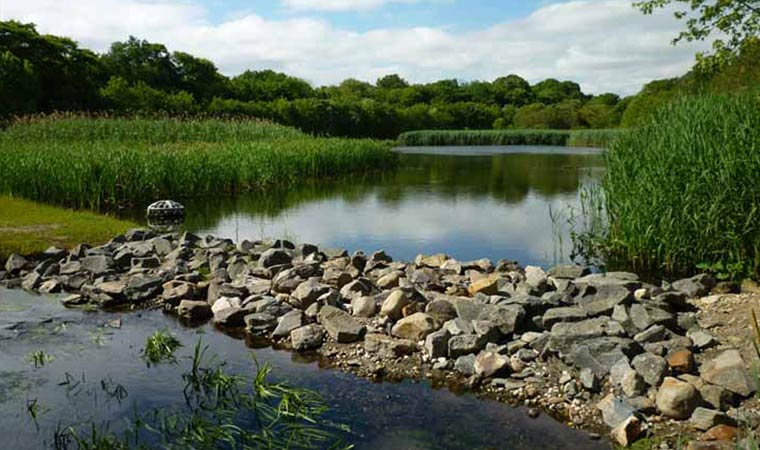
Restoration of Massapequa Creek Preserve
Massapequa, NY
Show Project Details
The installation of sanitary sewers and increase in groundwater withdrawals for public water consumption lowered groundwater elevations in the 423-acre Massapequa Preserve. Streamflow was reduced and water levels lowered in the four ponds and two lakes. Designs were created to mitigate the effects of lowered groundwater by augmenting streamflow, making improvements to the streams and ponds, and better managing stormwater. A 1,100 gpm streamflow augmentation system was designed to bring groundwater to the upper portion of the stream channel. Stream bank stabilization designs included branch packing, live stakes, fascines, degradable geotextiles and native plantings. New berms in the ponds separate stormwater from cooler baseflow. Drainage swales divert stormwater from the ponds to the red maple swamp for stormwater treatment, recharge, irrigation, and swamp preservation. End-of-pipe treatment units remove stormwater sediments and contaminants.
The improvements benefit the wetlands and stream channel of the preserve, water discharged to the South Shore Estuary. Cameron Engineering prepared a Draft EIS, a Final EIS and a successful Clean Air/Clean Water Bond Act grant for $1,300,000.
This project received the ACEC NY 2012 Gold Award for Engineering Excellence.
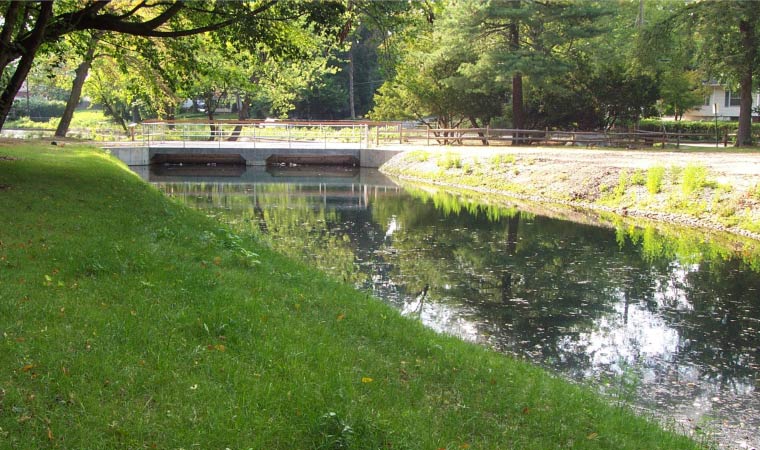
Baxter Pond Restoration
Baxter Estates, NY
Show Project Details
Cameron Engineering completed a topographic, hydrographic and ecological survey of the 3.6 acre pond and stream, defined the watershed drainage area, and sampled pond and stream sediments. We worked closely with NCDPW and Parks, and the NYSDEC. We developed a plan for the site’s rehabilitation including analysis of sediment contaminant issues, recommendations for methods for sediment removal and disposal, pond and stream restoration techniques, and methods for improving water quality and wildlife habitat.
A NYSDEC permit was obtained and the detailed engineering designs for stormwater management, environmental mitigation and stream bank stabilization were completed. The project was constructed in 2002 and was the first habitat restoration project constructed that was funded in part by the NY Clean Air/Clean Water Bond Act.
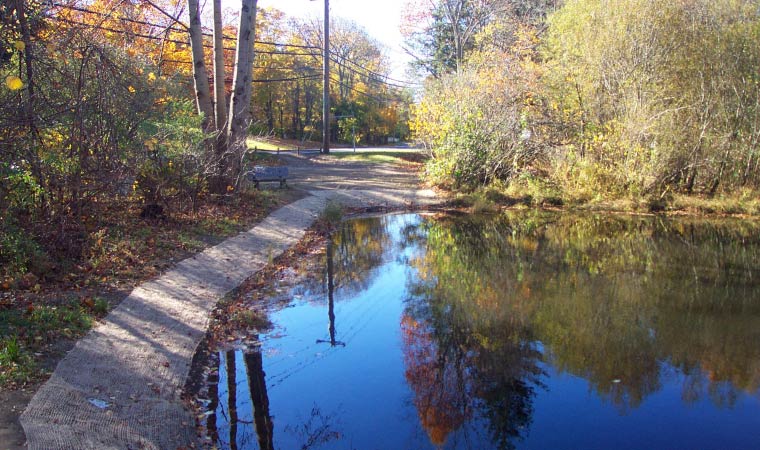
Fiske Pond Restoration
Huntington, NY
Show Project Details
Cameron Engineering designed improvements to Fiske Pond Park that have restored its ecological function and role in stormwater treatment while preserving its value to the community as a unique and beautiful aquatic retreat. Cameron Engineering provided engineering solutions with minimal environmental impact. The existing concrete spillway was replaced by a more aesthetically-pleasing two-stage spillway designed to accommodate varying storm events.
Approximately 800 cubic yards of material were removed from the pond and reused in Village composting and landscaping processes. Cameron Engineering’s design included installation of sediment collection devices to intercept stormwater borne sediments and floatables while maintaining pond aesthetics with structures invisible to the public. The project included repair of a breached earthen embankment with a PVC sheet piling inner core, earthen fill and establishment of native grasses for bank stabilization. Additional improvements included creation of new pond vistas and improved runoff collection and storage for adjacent residential roadways and West Neck Road. State and Federal permits were secured. Part of the funding was provided by a NYS Clean Air/Clean Water Bond Act grant.
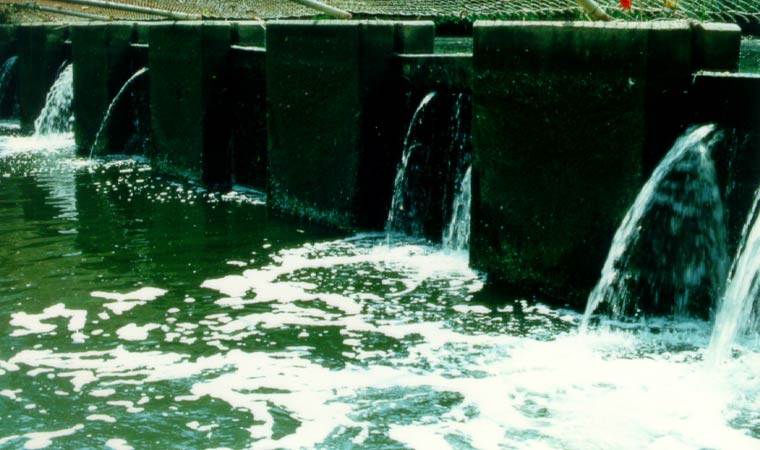
Revitalization of Mill Dam Pond
Huntington, NY
Show Project Details
Years of unattenuated stormwater flow has severely degraded the ecology and stormwater storage capacity of Mill Dam Pond. Pond sediments were sampled and recommendations were made to deepen and regrade the pond and restore habitat. Spillway modifications and self-regulating tide gates were proposed to reintroduce tidal flow and substantially increase stormwater storage in the pond. Conceptual design included stormwater sediment capture in a vegetated basin with an overflow to a 2-acre constructed stormwater treatment wetland. Deteriorated culverts were recommended for replacement with an open stream channel from the new wetland to the restored pond. Walkways along the new wetland, stream channel and pond were proposed for passive recreational use. A Clean Air/Clean Water Bond Act application was prepared which awarded the town $1.9 million.
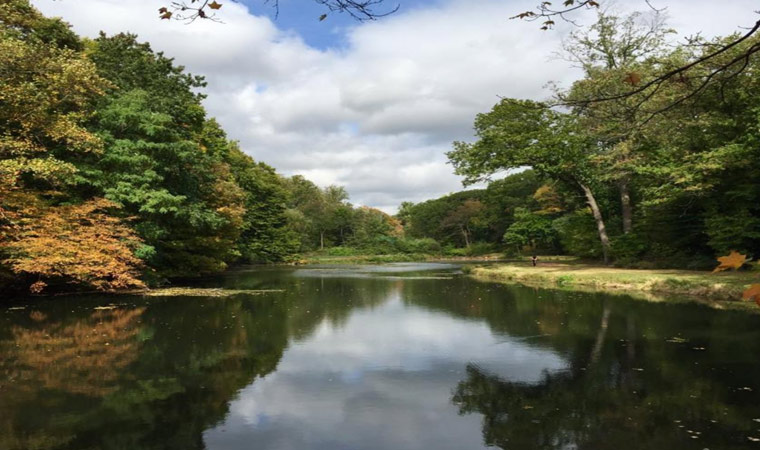
Carpenter’s Pond Restoration
New Rochelle, NY
Show Project Details
The restoration of Carpenters Pond included measures to improve water quality, expand aquatic habitat, and preserve the aesthetic appeal of this community pond. The pond had experienced substantial input of stormwater-borne sediments over the course of many decades. Pond depths had shallowed, stormwater runoff contaminants had accumulated, and water quality and habitat had degraded. Pond bathymetry and area topography was mapped and sediments sampled and analyzed. The Carpenters Pond drainage area was calculated and flows estimated for various storm events.
Cameron Engineering designed a forebay of articulated concrete block with a concrete spillway that would overflow into the pond. A ‘GrassPave’ drive was included in the design to allow an excavator and truck direct access to the forebay for annual maintenance. The drive also served as a new pedestrian walk along the pond edge. Dredging was specified to improve pond depths and remove organic rich materials that could contribute to pond eutrophication. Dewatering and maintenance of stormwater flows during construction were accommodated in the design. Some of the dredged material was reused on site to lower disposal costs. The pond edges were regraded to create aquatic ‘benches’ to support the growth of aquatic vegetation and the invasive common reed (Phragmites) removed. Designs were also included for the replacement of the emergency drain valve and valve stem.
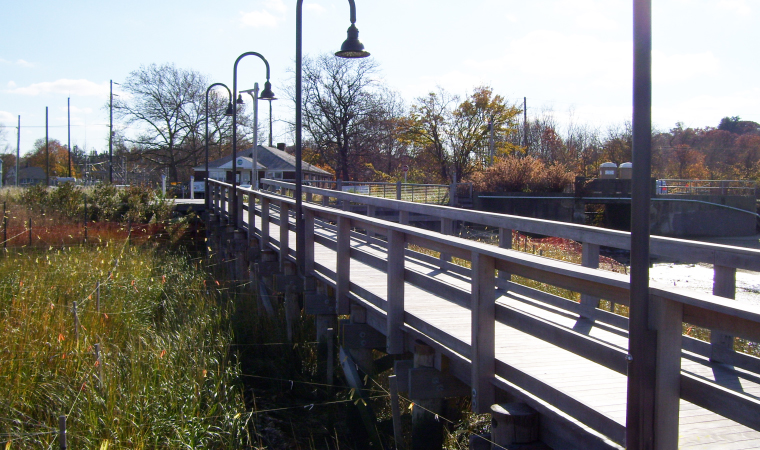
Oyster Bay Western Waterfront
Oyster Bay, NY
Show Project Details
Cameron Engineering developed a Master Plan for the hamlet of Oyster Bay’s western waterfront. The site consisted of three Town-owned parcels and one State-owned parcel totaling approximately 16 acres on Oyster Bay Harbor. Cameron worked with a Steering Committee comprising of a dozen agencies, local business and civic groups and conducted a public outreach campaign to gather ideas for uses of the site. The Master Plan included a Community/Environmental Education Center, a maritime history museum, ship restoration workshop, government offices, wetland restoration and creation for stormwater treatment, baymen’s access, public pier, path system, beach, and boat launch. Cameron prepared the Generic Environmental Impact Statement for the Master Plan and assisted the Town and the State in obtaining over $4.6 million in grant funding. Cameron participated in the development of the NYSDEC’s Custodial Management Plan for the future operation of their portion of the site. Cameron performed design services and provided construction oversight for multiple phases of the project.

